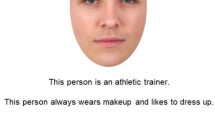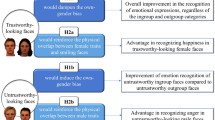Abstract
Beliefs about who typically expresses which emotions are deeply ingrained and likely affect how people perceive and respond to emotional displays by others. We examined how emotional expressions and social status separately and in combination affect how quickly participants can categorize faces by their gender. The speed with which people categorize targets is informative about what combinations are expected or not. In Study 1, participants categorized the gender of targets displaying angry, happy, and neutral expressions. Response times were slower to incongruent gender-emotion pairs (angry female faces, happy male faces) relative to both neutral and congruent expressions. In Study 2, participants again categorized the gender of targets, this time presented as having high or low status. Target status affected response times to female targets only. Female targets were categorized more slowly when they both had high status and expressed anger (vs. happiness or no emotion). No differences by emotion were found for low-status female targets. In sum, anger was incongruent with women at an automatic level both when they had high status and when their status was unmarked, whereas explicit low-status information eliminated this incongruity. These data confirm the existence of deeply-ingrained associations linking status, gender, and emotion and underscore the importance of emotional expression and status in how women are perceived.



Similar content being viewed by others
Notes
Although the gender-status congruent trials (i.e., high-status male and low-status female) arguably could be considered replications of the no-status trials in Study 1, we recognized that contextually-specific status information should be distinguished from assumed status based on gender and might differentially influence responses to the targets. Therefore, an additional 34 participants completed a revised version of the experiment in which a set of targets with no status information was presented first, followed by the high- and low-status sets. As expected, analyses of the no-status information trials replicated the patterns found in Study 1.
The main effect of status was marginally significant, F(1, 72) = 2.88, p = .094, with faster response times to high-status (M = 577.2, SE = 6.6) than to low-status faces (M = 571.0, SE = 6.5).
References
Algoe, S. B., Buswell, B. N., & DeLamater, J. D. (2000). Gender and job status as contextual cues for the interpretation of facial expression of emotion. Sex Roles, 42(3), 183–208. doi:10.1023/A:1007087106159.
Becker, D. V., Kenrick, D. T., Neuberg, S. L., Blackwell, K. C., & Smith, D. M. (2007). The confounded nature of angry men and happy women. Journal of Personality and Social Psychology, 92(2), 179–190. doi:10.1037/0022-3514.92.2.179.
Bijlstra, G., Holland, R. W., & Wigboldus, D. H. J. (2010). The social face of emotion recognition: Evaluations versus stereotypes. Journal of Experimental Social Psychology, 46, 657–663. doi:10.1016/j.jesp.2010.03.006.
Brescoll, V. L., & Uhlmann, E. L. (2008). Can an angry woman get ahead? Status conferral, gender, and expression of emotion in the workplace. Psychological Science, 19(3), 268–275. doi:10.1111/j.1467-9280.2008.02079.x.
Brody, L. R., & Hall, J. A. (2008). Gender and emotion in context. In M. Lewis, J. M. Haviland-Jones, & L. F. Barrett (Eds.), Handbook of emotions (Vol. 3, pp. 395–408). New York: Guilford Press.
Brody, L. R., Lovas, G. S., & Hay, D. H. (1995). Gender differences in anger and fear as a function of situational context. Sex Roles, 32(1–2), 47–48. doi:10.1007/BF01544757.
Carney, D., Hall, J. A., & Smith LeBeau, L. (2005). Beliefs about the nonverbal expression of social power. Journal of Nonverbal Behavior, 29(2), 105–123. doi:10.1007/s10919-005-2743-z.
Condry, J., & Condry, S. (1976). Sex differences: A study of the eye of the beholder. Child Development, 47(3), 812–819.
Dépret, E., & Fiske, S. T. (1999). Perceiving the powerful: Intriguing individuals versus threatening groups. Journal of Experimental Social Psychology, 35(5), 461–480. doi:10.1006/jesp.1999.1380.
Dovidio, J. F., & Fazio, R. H. (1992). New technologies for the direct and indirect assessment of attitudes. In J. M. Tanur (Ed.), Questions about questions: Inquiries into the cognitive bases of surveys (pp. 204–237). New York, NY: Russell Sage Foundation.
Eagly, A. H., & Carli, L. L. (2007). Through the labyrinth: The truth about how women become leaders. Boston: Harvard Business School Press.
Eagly, A. H., & Steffen, V. J. (1984). Gender stereotypes stem from the distribution of women and men into social roles. Journal of Personality and Social Psychology, 46(4), 735–754. doi:10.1037/0022-3514.46.4.735.
Eagly, A. H., Makhijani, M. G., & Klonsky, B. G. (1992). Gender and the evaluation of leaders: A meta-analysis. Psychological Bulletin, 111(1), 3–22. doi:10.1037/0033-2909.111.1.3.
Ekman, P., & Friesen, W. V. (1976). The Pictures of Facial Affect. Palo Alto, CA: Consulting Psychologists Press.
Everhart, D. E., & Harrison, D. W. (2000). Facial affect perception in anxious and nonanxious men without depression. Psychobiology, 28(1), 90–98.
Fabes, R. A., & Martin, C. L. (1991). Gender and age stereotypes of emotionality. Personality and Social Psychology Bulletin, 17(5), 532. doi:10.1177/0146167291175008.
Fazio, R. H., Jackson, J. R., Dunton, B. C., & Williams, C. J. (1995). Variability in automatic activation as an unobtrusive measure of racial attitudes: A bona fide pipeline? Journal of Personality and Social Psychology, 69(6), 1013. doi:10.1037/0022-3514.69.6.1013.
Hall, J. A., Coats, E. J., & Smith LeBeau, L. (2005). Nonverbal behavior and the vertical dimension of social relations: A meta-analysis. Psychological Bulletin, 131(6), 898–924. doi:10.1037/0033-2909.131.6.89.
Hecht, M. A., & LaFrance, M. (1998). License or obligation to smile: The effect of power and sex on amount and type of smiling. Personality and Social Psychology Bulletin, 24(12), 1332. doi:10.1177/01461672982412007.
Hess, U., Senécal, S., Kirouac, G., Herrera, P., Philippot, P., & Kleck, R. E. (2000). Emotional expressivity in men and women: Stereotypes and self-perceptions. Cognition and Emotion, 14(5), 609–642. doi:10.1080/02699930050117648.
Hess, U., Adams, R. B., Grammer, K., & Kleck, R. E. (2009). Face gender and emotion expression: Are angry women more like men? Journal of Vision, 9(12), 19, 1–8. doi:10.1167/9.12.19.
Hugenberg, K. (2005). Social categorization and the perception of facial affect: Target race moderates the response latency advantage for happy faces. Emotion, 5(3), 267–276. doi:10.1037/1528-3542.5.3.267.
Hugenberg, K., & Sczesny, S. (2006). On wonderful women and seeing smiles: Social categorization moderates the happy face response latency advantage. Social Cognition, 24(5), 516–539. doi:10.1521/soco.2006.24.5.516.
Johnson, K. L., Freeman, J. B., & Pauker, K. (2011). Race is gendered: How covarying phenotypes and stereotypes bias sex categorization. Journal of Personality and Social Psychology. doi:10.1037/a0025335.
Kring, A. M. (2000). Gender and anger. In A. H. Fischer (Ed.), Gender and emotion: Social psychological perspectives (pp. 211–231). Edinburgh: Cambridge University Press.
LaFrance, M., & Banaji, M. (1992). Toward a reconsideration of the gender-emotion relationship. In M. S. Clark (Ed.), Emotion and social behavior (pp. 178–201). Newbury Park: Sage.
LaFrance, M., Hecht, M. A., & Paluck, E. L. (2003). The contingent smile: A meta-analysis of sex differences in smiling. Psychological Bulletin, 129(2), 305–334. doi:10.1037/0033-2909.129.2.30.
Lewis, K. M. (2000). When leaders display emotion: How followers respond to negative emotional expression of male and female leaders. Journal of Organizational Behavior, 21(2), 221–234. doi:10.1002/(SICI)1099-1379(200003)21:2<221:AID-JOB36>3.0.CO;2-0.
MacLeod, C. M. (1991). Half a century of research on the Stroop effect: An integrative review. Psychological Bulletin, 109, 163–203. doi:10.1037/0033-2909.109.2.163.
Maner, J. K., DeWall, C. N., & Gailliot, M. T. (2008). Selective attention to signs of success: Social dominance and early stage interpersonal perception. Personality and Social Psychology Bulletin, 34(4), 488–501. doi:10.1177/0146167207311910.
Maybury, K. K. (1997). The influence of status and sex on observer judgements of anger displays (Unpublished doctoral dissertation). University of California, Davis.
Moretti, M. M., Charlton, S., & Taylor, S. (1996). The effects of hemispheric asymmetries and depression on the perception of emotion. Brain and Cognition, 32(1), 67–82.
Plant, E. A., Hyde, J. S., Keltner, D., & Devine, P. G. (2000). The gender stereotyping of emotions. Psychology of Women Quarterly, 24(1), 81–92. doi:10.1111/j.1471-6402.2000.tb01024.x.
Plant, E. A., Kling, K. C., & Smith, G. L. (2004). The influence of gender and social role on the interpretation of facial expressions. Sex Roles, 51(3–4), 187–196. doi:10.1023/B:SERS.0000037762.10349.13.
Ratcliff, R. (1979). Group reaction time distributions and an analysis of distribution statistics. Psychological Bulletin, 86(3), 446–461.
Ratcliff, R. (1993). Methods for dealing with reaction time outliers. Psychological Bulletin, 114(3), 510. doi:10.1037/0033-2909.114.3.510.
Ratcliff, N. J., Franklin, R. G, Jr, Nelson, A. J., & Vescio, T. K. (2012). The scorn of status: A bias toward perceiving anger on high-status faces. Social Cognition, 30(5), 631–642. doi:10.1521/soco.2012.30.5.631.
Ridgeway, C. L. (2001). Gender, status, and leadership. Journal of Social Issues, 57(4), 637–655. doi:10.1111/0022-4537.00233.
Rotter, N. G., & Rotter, G. S. (1988). Sex differences in the encoding and decoding of negative facial emotions. Journal of Nonverbal Behavior, 12(2), 139–148.
Rudman, L. A., Moss-Racusin, C. A., Phelan, J. E., & Nauts, S. (2012). Status incongruity and backlash effects: Defending the gender hierarchy motivates prejudice against female leaders. Journal of Experimental Social Psychology, 48(1), 165–179. doi:10.1016/j.jesp.2011.10.008.
Stroessner, S. J. (1996). Social categorization by race or sex: Effects of perceived non-normalcy on response times. Social Cognition, 14(3), 247–276. doi:10.1521/soco.1996.14.3.247.
Thomas, E. L., Dovidio, J. F., & West, T. V. (2014). Lost in the categorical shuffle: Evidence for the social non-prototypicality of Black women. Cultural Diversity and Ethnic Minority Psychology, 20(3), 370–376. doi:10.1037/a0035096.
Tiedens, L. Z., Ellsworth, P. C., & Mesquita, B. (2000). Sentimental stereotypes: Emotional expectations for high- and low-status group members. Personality and Social Psychology Bulletin, 26(5), 560. doi:10.1177/0146167200267004.
Acknowledgments
We thank John F. Dovidio for his helpful comments on earlier drafts of this article.
Conflict of interest
The authors declare that they have no conflict of interest.
Author information
Authors and Affiliations
Corresponding author
Rights and permissions
About this article
Cite this article
Smith, J.S., LaFrance, M., Knol, K.H. et al. Surprising Smiles and Unanticipated Frowns: How Emotion and Status Influence Gender Categorization. J Nonverbal Behav 39, 115–130 (2015). https://doi.org/10.1007/s10919-014-0202-4
Published:
Issue Date:
DOI: https://doi.org/10.1007/s10919-014-0202-4




